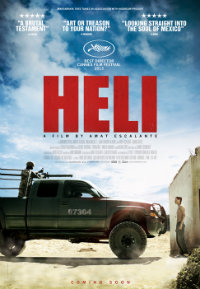Fast, Cheap and Out of Control: Escalante’s Mexico Still Suffering
 Amat Escalante doesn’t fall far from his own tree with Heli, graphic violence once again contours what is necessarily difficult to fathom, swallow and watch. Employing crisp, unflinching, arresting visuals and a genial temporal and spatial mapping, the more alluring portions in this fractured timeline narrative are the protagonist’s gradual transformation into machismo and rarely addressed forms of psychological pathos. Tantalized with extreme, shock-value friendly, albeit necessary violent depictions that simply underline desensitized conditioning on a much smaller scale, here the filmmaker can be faulted not for his prowess in framing or filling his composition, but for trying to package several footnotes that might have contributed to the hemorrhaging nation.
Amat Escalante doesn’t fall far from his own tree with Heli, graphic violence once again contours what is necessarily difficult to fathom, swallow and watch. Employing crisp, unflinching, arresting visuals and a genial temporal and spatial mapping, the more alluring portions in this fractured timeline narrative are the protagonist’s gradual transformation into machismo and rarely addressed forms of psychological pathos. Tantalized with extreme, shock-value friendly, albeit necessary violent depictions that simply underline desensitized conditioning on a much smaller scale, here the filmmaker can be faulted not for his prowess in framing or filling his composition, but for trying to package several footnotes that might have contributed to the hemorrhaging nation.
Sangre (2005), his brilliant debut film was a sardonic, nihilistic take on an already fragile nation, while Los basterdos (2008) was hell-bent on symbolically addressing the humiliation brought about by the imperialist neighbor of the north, with his third feature, Escalante updates the peskiest cancer growths of native Mexico joining his filmmaker peers (comparisons to oft-partner Carlos Reygadas and Gerardo Naranjo are inevitable) in exploring the nature of this corrosion.
Equipped with a non-pro cast, this follows Heli (Armando Espitia), the titular character whose name is awfully close in appellation to the word hell – non-coincidentally he embarks on a hellish bad luck streak where intentions to do good are thwarted by the most extreme of circumstances. The household unit consists of day laborer father, Heli’s mother/wife, infant son, and Heli’s teen sister Estela (Andrea Vergara) who ultimately would follow in the pathway where kids have kids of their own – almost the norm under the thorny guise of a faith-based society. Her new beau, who is closer to manhood than childhood is ultimately the one who brings the curse upon the family – in an attempt to better one’s future, we find out why and how backend deals can occur between the two forces in power. Those in uniform and the drug cartels not only co-exist, but they hold onto power maintaining a working relationship.
Heli is left with very little options; even a detective working on the case exploits the situation. Escalante frequently details the power struggle —best exemplified with the introductory sequence that will later be revisited in which two bloodied, still breathing victims are lumped together in a pick-up truck. Camera pans away from a boot firmly planted on his head – symbolically expressing the oppressive nature of the stance. That same sequence camera lingers around long enough, demonstrating the prowess in composition but also details how these men in black are far from being galaxy defenders – instead the reeks of corrupted nature of those put into powerful positions of authority.
Expertly lensed by cinematographer Lorenzo Hagerman, rendering the backdrop as an unforgiving, dusty languid one – symbolically pumping the film with the overall notion that this is land without much opportunity, Escalante, a fan of slow tracking shots and the mounted still frame further details what has become the habitual in the incline in violent deaths and torture with an overall distillation.
Escalante’s minimalist canvas suffers slightly, the protagonist’s fate and overall numbness is far removed from what normally should be a gut-wrenching tale – this is in apart due to the incremental nature of film’s narrative to continually add examples on the issue of those that exploit and those who are exploited, with many key denouements left without a purposeful closure of sorts. While soft-core would definitely not have been the best of approaches, a more chiseled outline might have made Heli as the poster child/film for a Mexico that is hurting and a social epidemic without end in sight.
Reviewed at the 2013 Cannes Film Festival on May 15th – Main Competition section
115 Minutes.


